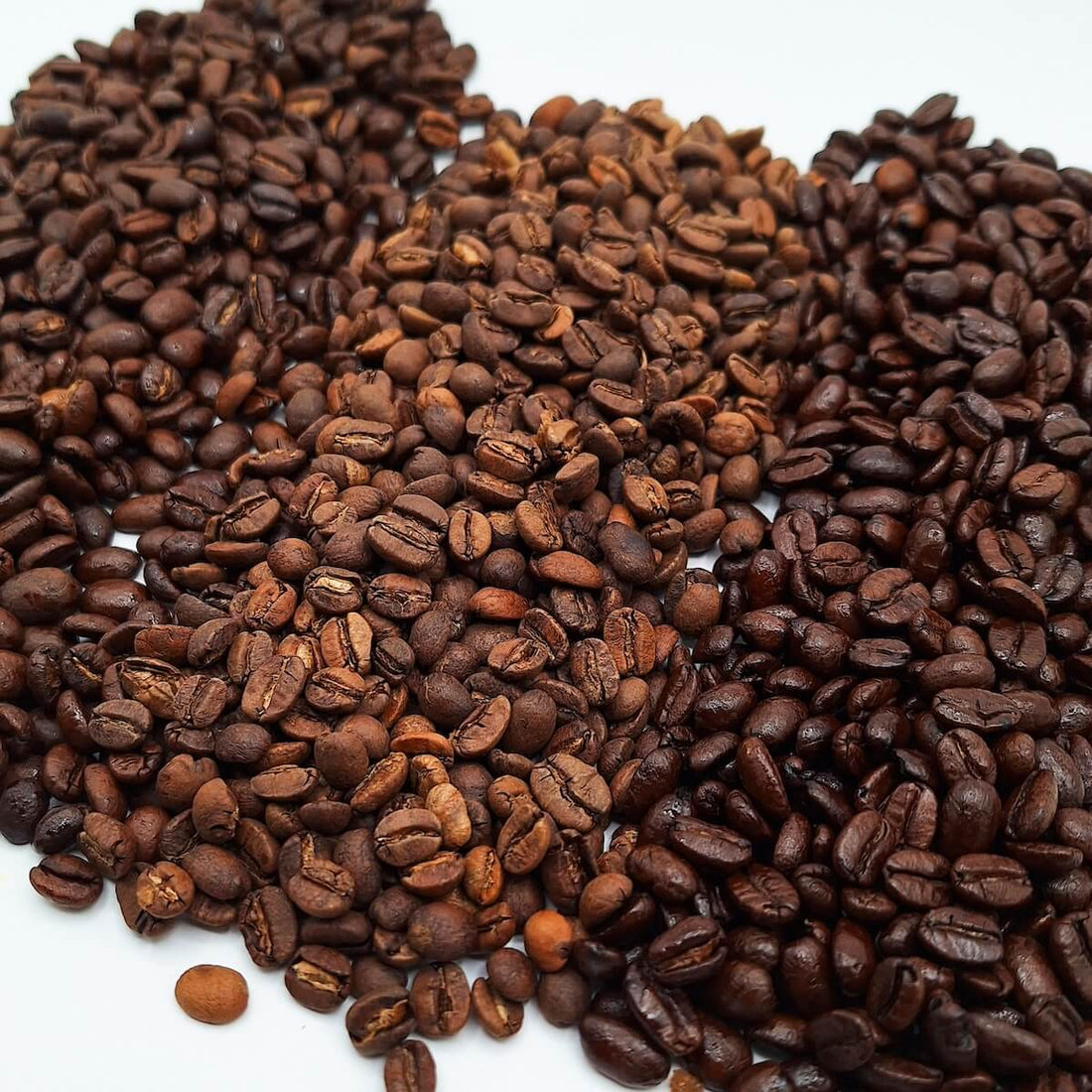The Ultimate Guide to Coffee Grading

What Is Coffee Grading and Why Does It Matter?
Ever wondered why some coffees cost $40 a pound while others barely break $10? Or why that Ethiopian you tried last week tasted like blueberries and honey while your office coffee tastes like, well... office coffee? The answer lies largely in coffee grading—the intricate system that separates the extraordinary from the ordinary in the world of coffee beans.
At Carolina Coffee Works, we obsess over these distinctions because they directly impact what ends up in your cup. Coffee grading isn't just industry jargon; it's the backbone of quality assurance in the coffee world and the secret language of exceptional coffee experiences.
The Fundamentals of Coffee Grading
Coffee grading is essentially a quality assessment system that evaluates coffee beans based on both physical attributes and taste characteristics. Think of it as a report card for your beans—one that measures everything from their size and density to their flavor complexity and aroma.
Before a single bean reaches our roastery at Carolina Coffee Works, it has already undergone rigorous evaluation. These evaluations aren't arbitrary—they're standardized processes designed to ensure consistency and quality across the industry.
Physical Grading: What We Can See and Measure
Size Matters
Coffee beans are meticulously screened and sorted by size using screens with precisely measured holes (measured in 1/64th of an inch). These screens, numbered from 8 to 20, allow buyers and roasters to select beans that will roast evenly and produce consistent results.
Larger beans (typically screen sizes 15-18) aren't necessarily better, but consistency in size is crucial for even roasting. When beans of drastically different sizes roast together, smaller beans may over-roast while larger ones remain underdeveloped—resulting in imbalanced flavors.

Counting Defects: The Bean Inspection
Perhaps the most critical aspect of physical grading is defect analysis. Trained graders meticulously inspect samples for primary and secondary defects:
Primary Defects (serious flaws that significantly impact flavor):
- Full black beans
- Full sour beans
- Pod/cherry (unremoved fruit)
- Fungus-damaged beans
- Foreign material
Secondary Defects (minor issues with less impact):
- Partial black beans
- Broken/chipped beans
- Slight insect damage
- Shell beans (malformed)
- Slightly immature beans
The SCAA (Specialty Coffee Association of America) system allows for different levels of defects depending on the grade:
- Specialty Grade (1): 0 primary defects, max 5 secondary defects
- Premium Grade (2): 0 primary defects, max 8 secondary defects
- Exchange Grade (3): Max 5 primary defects, max 15 secondary defects
- Below Standard Grade (4): More than 5 primary defects
- Off Grade (5): More than 15% defects by weight
Density, Color, and Moisture
Other physical factors evaluated include:
-
Density: Denser beans (those that sink quickly in water) typically have higher concentrations of sugars and oils—translating to more complex flavors. High-altitude coffees tend to be denser.
-
Color: Uniform color indicates even ripening and processing. Discoloration can signal improper drying, fermentation issues, or aging.
-
Moisture Content: Properly dried coffee should have a moisture content between 10-12%. Too dry (below 9%) and the beans become brittle; too moist (above 12.5%) and they risk mold development during storage.
Sensory Evaluation: The Art of Cupping
While physical grading provides objective data, coffee's true value emerges through sensory evaluation—a process called cupping. This is where science meets art in the coffee world.

Professional cuppers evaluate roasted samples for:
- Fragrance/Aroma: The smell of ground coffee (dry) and brewed coffee (wet)
- Flavor: The principal character of the coffee
- Aftertaste: The length and quality of flavor that lingers
- Acidity: The pleasant brightness or sharpness (not sourness)
- Body: The tactile feeling and weight in the mouth
- Balance: How well all elements work together
- Sweetness: Natural sugar-like qualities
- Uniformity: Consistency across multiple cups
- Cleanliness: Freedom from off-flavors
- Overall Impression: The cupper's holistic assessment
At Carolina Coffee Works, our roasters use this exact protocol to evaluate every coffee we source, ensuring only the finest beans make it to our roastery.
Major Grading Systems Around the World
Coffee grading isn't universal—different growing regions have developed their own systems based on local traditions, varieties, and market demands.
The SCAA Grading System
The Specialty Coffee Association of America established what's become the gold standard for specialty coffee grading, particularly for Arabica coffees. This system uses a 100-point scale:
- Specialty Grade (80-100 points): Exceptional quality with distinct attributes and minimal defects
- Premium Grade (70-79 points): Good quality coffee with some distinctive characteristics
- Exchange Grade (60-69 points): Average quality, suitable for commercial applications
- Below Standard Grade (50-59 points): Low-quality coffee with noticeable defects
- Off Grade (Below 50 points): Very poor quality with numerous defects
Other Regional Systems
- Colombia's Excelso and Supremo: Based primarily on bean size rather than cup quality
- Kenya's AA, AB, PB Classification: Combines bean size (AA being largest) with auction cupping scores
- Ethiopia's Grades 1-9: Combines physical sorting with cup quality assessment
- Brazil's Type System (Type 2-8): Based on defect count (Type 2 having fewest defects)
Each system reflects the unique qualities valued in that region's coffee culture. At Carolina Coffee Works, we source beans from multiple regions, so we understand these various systems to ensure we're getting the best each origin has to offer.
From Farm to Cup: How Grading Impacts Coffee Production
Coffee grading isn't just a final evaluation—it shapes the entire production process:
For Farmers
Grading directly impacts farmer income, with higher grades commanding premium prices—sometimes 2-3 times more than commercial-grade coffee. This incentivizes better agricultural practices:
- More selective harvesting (picking only ripe cherries)
- Improved processing techniques
- Better drying and storage methods
- Investment in better plant varieties
For Roasters
For specialty roasters like us at Carolina Coffee Works, grading is crucial for:
- Creating consistent roasting profiles
- Predicting how beans will develop during roasting
- Appropriately pricing finished products
- Making informed blending decisions
- Communicating quality expectations to customers

For Consumers
Understanding coffee grading helps coffee lovers:
- Make more informed purchasing decisions
- Appreciate the value behind premium prices
- Develop more nuanced tasting abilities
- Better articulate preferences to baristas and retailers
The Real-World Impact of Coffee Grading
To put this all in perspective, let's compare what grading means for different types of coffee:
Specialty Grade (80+ points): These coffees have distinctive flavor profiles with clear origin character. They might taste like berries, chocolate, caramel, or tropical fruits with complex acidity and sweetness. They're meticulously processed with virtually no defects.
Commercial Grade (below 80 points): These coffees have simpler flavor profiles, often described as "just coffee." They may have slight defects that create muted flavors or slight bitterness. While still drinkable, they lack the complexity and nuance of specialty grades.
Low Grade: These coffees often contain significant defects that create unpleasant flavors—harsh bitterness, fermented notes, or flat, woody characteristics. These typically end up in instant coffee or heavily flavored commercial products where additional ingredients mask defects.
How to Use Your Coffee Grading Knowledge
Now that you understand the basics of coffee grading, how can you apply this knowledge to enhance your coffee experience?
When Buying Coffee
- Look for transparency about grade, processing method, and origin
- Check roast dates (fresh is best, regardless of grade)
- Ask about cupping scores for specialty coffees
- Be willing to pay more for higher grades—the difference is real
- Try coffees from the same region but different grades to train your palate
What We Do at Carolina Coffee Works
At Carolina Coffee Works, we focus primarily on specialty-grade coffees (80+ points) because we believe life's too short for mediocre coffee. Our sourcing team works directly with importers who provide detailed grading information for every lot we consider.
We regularly cup coffees before purchasing and again before roasting to ensure quality hasn't degraded during shipping or storage. This commitment to quality control means you can trust that every bag of Carolina Coffee Works beans represents the best expression of its origin.
Beyond the Grade: The Human Element
While grading systems provide valuable standardization, they don't tell the complete story. Behind every coffee is a community of farmers whose livelihood depends on fair prices for their crops. True coffee quality encompasses not just physical and sensory attributes but also:
- Sustainable farming practices
- Fair compensation for producers
- Ethical business relationships
- Environmental stewardship
That's why at Carolina Coffee Works, we consider these factors alongside traditional grading metrics when selecting our coffees. We believe the best coffees are not just those that score highest but those produced with integrity throughout the supply chain.
Experience the Difference for Yourself
Coffee grading might seem technical, but its impact is anything but abstract—it's something you can taste in every cup. We invite you to explore our selection of meticulously graded, freshly roasted coffees at Carolina Coffee Works and experience the difference quality makes.
Whether you're just beginning your specialty coffee journey or you're a seasoned enthusiast, understanding coffee grading opens up a deeper appreciation for what's in your cup. And that awareness makes every sip more meaningful.
Because when it comes to coffee, the details matter. And grading is how we measure those details.

